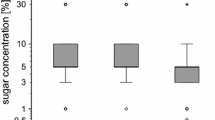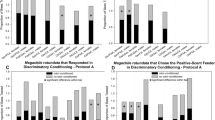Abstract
Learning in insects has been extensively studied using different experimental approaches. One of them, the proboscis extension response (PER) paradigm, is particularly well suited for quantitative studies of cognitive abilities of honeybees under controlled conditions. The goal of this study was to analyze the capability of three eusocial bee species to be olfactory conditioned in the PER paradigm. We worked with two Brazilian stingless bees species, Melipona quadrifasciata and Scaptotrigona aff. depilis, and with the invasive Africanized honeybee, Apis mellifera. These three species present very different recruitment strategies, which could be related with different odor-learning abilities. We evaluated their gustatory responsiveness and learning capability to discriminate floral odors. Gustatory responsiveness was similar for the three species, although S. aff. depilis workers showed fluctuations along the experimental period. Results for the learning assays revealed that M. quadrifasciata workers can be conditioned to discriminate floral odors in a classical differential conditioning protocol and that this discrimination is maintained 15 min after training. During conditioning, Africanized honeybees presented the highest discrimination, for M. quadrifasciata it was intermediate, and S. aff. depilis bees presented no discrimination. The differences found are discussed considering the putative different learning abilities and procedure effect for each species.






Similar content being viewed by others
References
Abramson CI, Aquino IS, Maurizete CS, Price JM (1997) Learning in the Africanized honey bee: Apis mellifera L. Physiol Behav 3:657–674
Abramson CI, Aquino IS, Stone SM (1999) Failure to find proboscis conditioning in one-day old africanized honey bees (Apis mellifera L.) and in adult uruçu honey bees (Melipona scutellaris). Int J Comp Psychol 12:242–262
Abramson CI, Aquino IS (2002) Behavioral studies of learning in the Africanized honey bee (Apis mellifera L.). Brain Behav Evol 59:68–86
Aguilar I, Briceño D (2002) Sounds in Melipona costaricensis (Apidae: Meliponini): effect of sugar concentration and nectar source distance. Apidologie 33:375–388
Aguilar I, Fonseca A, Biesmeijer JC (2005) Recruitment and communication of food source location in three species of stingless bees (Hymenoptera, Apidae, Meliponini). Apidologie 36:313–324
Biesmeijer JC, Slaa JE (2006) The structure of eusocial bee assemblages in Brazil. Apidologie 37:240–258
Bitterman ME, Menzel R, Fietz A, Schäfer S (1983) Classical conditioning of proboscis extension in honeybees (Apis mellifera). J Comp Psychol 97:107–119
Bouton ME, Moody EW (2004) Memory processes in classical conditioning. (Special issue: Neurobiology of cognition in laboratory animals: challenges and opportunities) Neurosci Biobehav Rev 28:663–674
Camargo JMF, Pedro SRD (1992) Systematics, phylogeny and biogeography of the Meliponinae (Hymenoptera, Apidae)—a minireview. Apidologie 23:599–522
Chabaud MA, Devaud JM, Pham-Delègue MH, Preat T, Kaiser L (2006) Olfactory conditioning of proboscis activity in Drosophila melanogaster. J Comp Physiol A 192:1335–1348
Chaffiol A, Laloi D, Pham-Delègue M (2005) Prior classical olfactory conditioning improves odour-cued flight orientation of honey bees in a wind tunnel. J Exp Biol 208:3731–3737
Daly KC, Smith BH (2000) Associative olfactory learning in the moth Manduca sexta. J Exp Biol 203:2025–2038
Farina WM, Grüter C, Díaz PC (2005) Social learning of floral odours inside the honeybee hive. Proc R Soc B 272:1923–1928
Frings H (1944) The loci of olfactory end-organs in the honeybee, Apis mellifera Linn. J Exp Zool 97:123–134
Frisch K von (1914) Der Farbensinn und Formensinn der Biene. Zool Jahrb Phys 37:1–238
Frisch K von (1919) Über den Geruchssinn der Bienen und seine blütenbiologische Bedeutung. Zool Jahrb Phys 37:1–238
Frisch K von (1967) The dance language and orientation of bees. Harvard University Press, Cambridge
Gerber B, Geberzahn N, Hellstern F, Klein J, Kowalksy O, Wüstenberg D, Menzel R (1996) Honey bees transfer olfactory memories established during flower visits to a proboscis extension paradigm in the laboratory. Anim Behav 52:1079–1085
Giurfa M (2003) Cognitive neuroethology: dissecting non-elemental learning in a honeybee brain. Curr Opin Neurobiol 13:726–735
Grüter C, Acosta LE, Farina WM (2006) Propagation of olfactory information within the honeybee hive. Behav Ecol Sociobiol 60:707–715
Heyes CM, Galef BG (1996) Social learning in animals: the roots of culture. Academic, San Diego
Hrncir M, Jarau S, Zucchi R, Barth FG (2000) Recruitment behavior in stingless bees, Melipona scutellaris and M quadrifasciata. II. Possible mechanisms of communication. Apidologie 31:93–113
Hrncir M, Jarau S, Zucchi R, Barth FG (2004) Thorax vibrations of a stingless bee (Melipona seminigra). II. Dependence on sugar concentration. J Comp Physiol A 190:549–560
Jarau S, Hrncir M, Zucchi R, Barth FG (2000) Recruitment behavior in stingless bees, Melipona scutellaris and M. quadrifasciata. I. Foraging at food sources differing in direction and distance. Apidologie 31:81–91
Kaiser L, Perez-Maluf R, Sandoz JC, Pham-Delegue MH (2003) Dynamics of odour learning in Leptopilina boulardi, a hymenopterous parasitoid. Anim Behav 66:1077–1084
Knudsen JT, Tollsten L, Bergström LG (1993) Floral scents. A checklist of volatile compounds isolated by head-space techniques. Phytochemistry 33:253–280
Laloi D, Sandoz JC, Picard-Nizou AL, Pham-Delègue MH (1999) Olfactory conditioning of the proboscis extension reflex in the bumble bee Bombus terrestris. Ann Soc Entomol France 35:154–158
Lindauer M (1948) Über die Einwirkung von Duft-und Geschmacksstoffen sowie anderer Faktoren auf die Tänze der Bienen. Z vergl Physiol 31:348–412
Lindauer M (1956) Über die Verständigung bei indischen Bienen. Z vergl Physiol 38:521–557
Lindauer M, Kerr WE (1958) Die gegenseitige Verständigung bei den stachellosen Bienen. Z Vergl Physiol 41:405–434
Menzel R (1999) Memory dynamics in the honeybee. J Comp Physiol A 185:323–340
Menzel R, Giurfa M (2001) Cognitive architecture of a mini-brain: the honeybee. Trends Cognit Sci 5:62–71
Menzel R, Müller U (1996) Learning and memory in honeybees: From behavior to neural substrates. Annu Rev Neurosci 19:379–404
Michener CD (2000) The bees of the world. The Johns Hopkins University Press, Baltimore
Nieh JC (1998a) The role of a scent beacon in the communication of food location by the stingless bee, Melipona panamica. Behav Ecol Sociobiol 43:47–58
Nieh JC (1998b) The food recruitment dance of the stingless bee, Melipona panamica. Behav Ecol Sociobiol 43:133–145
Nieh JC (2004) Recruitment communication in stingless bees (Hymenoptera, Apidae, Meliponini). Apidologie 35:159–182
Nieh JC, Tautz J, Spaethe J, Bartareau T (1999) The communication of food location by a primitive stingless bee, Trigona carbonaria. Zoology 102(4):238–246
Page RE, Erber J, Fondrk MK (1998) The effect of genotype on response thresholds to sucrose and foraging behavior of honey bees (Apis mellifera L.). J Comp Physiol A 182:489–500
Pankiw T, Page RE (1999) The effects of genotype, age, and caste on response thresholds to sucrose and foraging behavior of honeybees. J Comp Physiol A 185:207–213
Pankiw T, Nelson M, Page RE, Fondrk MK (2004) The communal crop: modulation of sucrose response thresholds of pre-foraging honey bees with incoming nectar quality. Behav Ecol Sociobiol 55:286–292
Pessotti I, Sénéchal AM (1981) Aprendizagem em abelhas. I: Discriminaçao simples em onze espécies. Acta Amazonica 11: 653–658
Roubik DW (1978) Competitive interactions between Africanized honeybees and native neotropical pollinators. Science 201:1030–1032
Roubik DW (1989) Ecology and natural history of tropical bees. Cambridge University Press, New York
Sandoz JC, Laloi D, Odoux JF, Pham-Delègue MH (2000) Olfactory information transfer in the honeybee: Compared efficiency of classical conditioning and early exposure. Anim Behav 59:1025–1034
Schacter DL, Buckner RL (1998) Priming and the brain. Neuron 20:185–195
Schmidt VM, Zucchi R, Barth FG (2003) A stingless bee marks the feeding site in addition to the scent path (Scaptotrigona aff. deplis). Apidologie 34:237–248
Schorkopf DLP, Jarau S, Francke W, Twele R, Zucchi R, Hrncir M, Schmidt VM, Ayasse M, Barth FG (2007) Spitting out information: Trigona bees deposit saliva to signal resource locations. Proc R Soc B 274:895–898
Sokal RR, Rohlf FJ (1995) Biometry: the principles and practice of statistics in biological research. 3rd edn. W. H. Freeman and Co, New York
Takeda K (1961) Classical conditioned response in the honeybee. J Insect Physiol 6:168–179
Tully T, Quinn WG (1985) Classical conditioning and retention in normal and mutant Drosophila melanogaster. J Comp Physiol A 157:263–277
Watanabe H, Kobayashi Y, Sakura M, Matsumoto Y, Mizunami M (2003) Classical olfactory conditioning in the cockroach Periplaneta americana. Zool Sci 20:1447–1454
Whitfield CW, Behura SK, Berlocher SH, Clark AG, Johnston JS, Sheppard WS, Smith DR, Suarez AV, Weaver D, Tsutsui ND (2006) Thrice out of Africa: ancient and recent expansions of the honey bee, Apis mellifera. Science 314:642–645
Wilms W, Wiechers B (1997) Floral resource partitioning between native Melipona bees and the introduced Africanized honey bee in the Brazilian Atlantic rainforest. Apidologie 28: 339–355
Wilms W, Imperatriz-Fonseca VL, Engels W (1996) Resource partitioning between highly eusocial bees and possible impact of the introduced Africanized honeybee on native stingless bees in the Brazilian Atlantic rainforest. Stud Neotrop Fauna Environ 31:137–151
Zar JH (1999) Biostatistical analysis. 4th edn. Prentice Hall, New Jersey
Acknowledgments
We specially want to thank Adelino Penatti for his daily help and technical assistance. We are also grateful to two anonymous reviewers for their insightful comments. This study was supported by funds from ANPCYT (01-12319), University of Buenos Aires (X 036) and CONICET (02049), to W. M. Farina and by a CAPES-SECyT international exchange grant (071/04). We declare that our experiments comply with the current laws of the country in which they were performed.
Author information
Authors and Affiliations
Corresponding author
Rights and permissions
About this article
Cite this article
Mc Cabe, S.I., Hartfelder, K., Santana, W.C. et al. Odor discrimination in classical conditioning of proboscis extension in two stingless bee species in comparison to Africanized honeybees. J Comp Physiol A 193, 1089–1099 (2007). https://doi.org/10.1007/s00359-007-0260-8
Received:
Revised:
Accepted:
Published:
Issue Date:
DOI: https://doi.org/10.1007/s00359-007-0260-8




